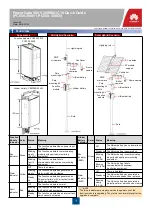
GB
USE
STARTING THE TOOL (fig. 3)
Clockwise rotation (to screw): push the lever (A).
Counterclockwise rotation (to unscrew): push the lever (A) and the button (B), at the same time.
NOTE: to make the bit turn when the motor is running an axial pressure must be exerted on the tool.
ATTACHMENT OF ACCESSORIES
(fig.4 = ERVIT922-944; fig.5 = ERVIT933 - 333)
Insertion: push firmly into the tool socket as indicated by the arrow until you hear the click of the spring that holds the tool
in place.
Removal: pull in the opposite direction.
Warning: to ensure operator safety, use only the accessories illustrated in the OBER catalogue.
SCREWDRIVING
ERVIT screwdrivers are designed for driving threaded elements. Their performance features are shown in table 1.
Experience will indicate the best way to perform this operation according to: the type of screw or nut; the shape of the
pieces to be fastened; the working position etc.
The normal sequence is: place the tool bit on the head of the screw; start the motor; press axially, the screw is to be
driven until you hear the characteristic "tick" made by the teeth of the clutch which has reached the set torque; stop the
motor; check to make sure the screw is properly tightened and adjust the clutch if necessary.
F
UTILISATION
DEMARRAGE
(fig.4 = ERVIT922-944; fig.5 = ERVIT933 - 333)
Rotation à droite (vissage): appuyer sur la manette (A).
Rotation à gauche (dévissage): appuyer sur les manettes (A) et (B) dans le même temps.
REMARQUE: si le moteur est en marche et si vous voulez faire tourner l'accessoire, il convient d'exercer une pression
axiale sur l'outil.
MONTAGE DES ACCESSOIRES (fig. 3)
Introduction: l'appuyer à fond sur le porte-outil, comme indiqué par la flèche, jusqu'à entendre le déclic du ressort
engageant l'outil dans son logement.
Extraction: tirer dans le sens opposé.
Avertissement: pour la sécurité de l’opérateur utiliser exclusivement des accessoires indiqués dans le catalogue OBER.
VISSAGE
Les visseuses ERVIT, dont les performances sont indiquées dans le tableau 1, ont été conçues pour le vissage
d'éléments filetés. La pratique vous enseignera la meilleure façon pour effectuer cette opération par rapport au: type de
vis ou d'écrou; forme des pièces à serrer; position de travail, etc.
La procédure normale est la suivante: saisissez la poignée de l’outil; mettez en route le moteur; appuyez en direction
axiale tout en suivant le vissage jusqu'à ce que vous entendiez le cliquetis des dents de la friction qui a atteint le couple
de serrage; arrétez le moteur; contrôlez le serrage obtenu et éventuellement réglez la friction.
18













































